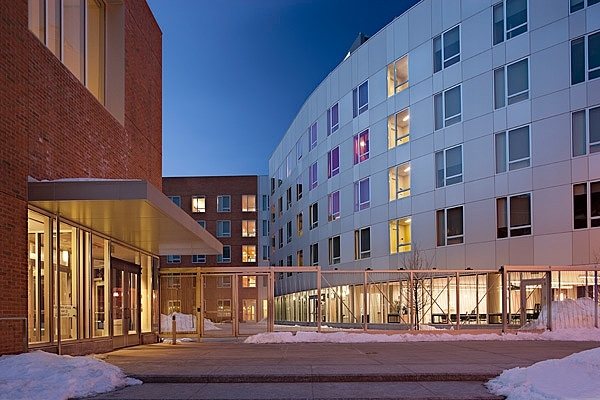On Nov. 13, Ashdown House (NW 35, a.k.a. “new Ashdown”) received a LEED-Gold certification from the U.S. Green Building Council. LEED (Leadership in Energy and Environmental Design) is a nationally recognized green building standard that awards building projects for sustainable design and performance.
Ashdown House, a graduate residence that houses more than 400 students and includes a full dining area, earned its Gold rating for a variety of green features: The building’s landscaping and irrigation systems use water from a non-potable source; a storm-water management system significantly reduces storm-water runoff; maximized daylight is available in 95 percent of regularly occupied spaces; and low-flow fixtures reduce water use by more than 20 percent. What’s more, care was taken to make the construction of Ashdown House as low-impact as possible: More than 10 percent of its materials included recycled content; more than 75 percent of the waste from the construction was recycled; and the building uses low-VOC (volatile organic compounds)-emitting paints, sealants and carpets.
“We are thrilled,” said Julia Ledewitz, LEED and Sustainability Coordinator for MIT. “Everyone at MIT should be very proud of this building. This Gold certification was made possible by collaboration between an excellent design and construction team and MIT’s Housing Department. Members of the MIT Community have long rallied around green design, and we now have a shining example of how a very beautiful building can also be sustainable.”
MIT has an Institute-wide goal of achieving LEED-Silver certification on all new buildings. LEED’s rating system awards points in the following categories: sustainable sites, water efficiency, energy and atmosphere, indoor environmental quality, and innovation and design. A basic number of points are required to earn a “Certified” rating, and buildings that earn higher scores can earn certification as Silver, Gold or Platinum buildings.
Building 46 (Brain and Cognitive Sciences) has LEED-Silver certification, and two building projects under way — for the David H. Koch Institute for Integrative Cancer Research and the new Sloan School of Management building — are both on track for Silver certification. W1 (a.k.a. “Old Ashdown”), which is in the design stage of a major renovation, should also get Silver certification.
Ashdown House’s architect was William Rawn Associates. The MIT Facilities Project Manager for Ashdown House was Gary Tondorf-Dick. The building opened on Aug. 13, 2008.
Ashdown House, a graduate residence that houses more than 400 students and includes a full dining area, earned its Gold rating for a variety of green features: The building’s landscaping and irrigation systems use water from a non-potable source; a storm-water management system significantly reduces storm-water runoff; maximized daylight is available in 95 percent of regularly occupied spaces; and low-flow fixtures reduce water use by more than 20 percent. What’s more, care was taken to make the construction of Ashdown House as low-impact as possible: More than 10 percent of its materials included recycled content; more than 75 percent of the waste from the construction was recycled; and the building uses low-VOC (volatile organic compounds)-emitting paints, sealants and carpets.
“We are thrilled,” said Julia Ledewitz, LEED and Sustainability Coordinator for MIT. “Everyone at MIT should be very proud of this building. This Gold certification was made possible by collaboration between an excellent design and construction team and MIT’s Housing Department. Members of the MIT Community have long rallied around green design, and we now have a shining example of how a very beautiful building can also be sustainable.”
MIT has an Institute-wide goal of achieving LEED-Silver certification on all new buildings. LEED’s rating system awards points in the following categories: sustainable sites, water efficiency, energy and atmosphere, indoor environmental quality, and innovation and design. A basic number of points are required to earn a “Certified” rating, and buildings that earn higher scores can earn certification as Silver, Gold or Platinum buildings.
Building 46 (Brain and Cognitive Sciences) has LEED-Silver certification, and two building projects under way — for the David H. Koch Institute for Integrative Cancer Research and the new Sloan School of Management building — are both on track for Silver certification. W1 (a.k.a. “Old Ashdown”), which is in the design stage of a major renovation, should also get Silver certification.
Ashdown House’s architect was William Rawn Associates. The MIT Facilities Project Manager for Ashdown House was Gary Tondorf-Dick. The building opened on Aug. 13, 2008.






